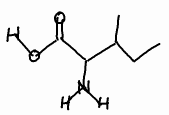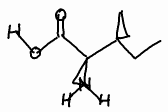|
| |
Get 15 % off on a Livescribe
Smartpen and help us maintain this site!
Instructions:
| This application can recognize 20 2D and 43 3D
amino acids! The
highlighted text
is the pen's display.
Once you have entered
Amino
Acids, you can select one of three options
from the vertical navigation menu:
| Option |
What you can
do? |
|
Tutorial
Mode: |
See the name of your drawing. |
|
Quiz Mode: |
Draw a given amino acid. |
|
Instructions Website: |
Remember where to find instructions. |
|
|
Tutorial
Mode: Draw the following structure lifting up the pen between drawing each
line or atomic symbol. Make sure the lines are straight and
longer than the separation of lines on college rule paper. Draw an atomic symbol after you draw a line that
represents one of its bonds. As you draw you may see the
molecular formula, e.g.,
CH2O2, or the
name of the amino acid that you have drawn, i.e.,
proline. You can start a new drawing by
reentering the
Tutorial Mode:, by double
tapping twice on the paper or by navigating right.
Draw the following structure lifting up the pen between drawing each
line or atomic symbol. Make sure the lines are straight and
longer than the separation of lines on college rule paper. Draw an atomic symbol after you draw a line that
represents one of its bonds. As you draw you may see the
molecular formula, e.g.,
CH2O2, or the
name of the amino acid that you have drawn, i.e.,
proline. You can start a new drawing by
reentering the
Tutorial Mode:, by double
tapping twice on the paper or by navigating right. |
Quiz Mode: When you see a display like
Draw
D-isoleucine: and you draw the lines and atomic
symbols like the drawing below left, the display will show
isoleucine, Draw D-isoleucine. Complete the two wedges like in the drawing
below right by drawing (in
one stroke) a figure that looks like a 7 or an L between
two points that already have a line between them. The wedge
means that the atom at the end of the stroke is in front of the atom
at the beginning of the stroke. Double tap on
the paper twice to retry the same question but change the direction
of the wedges to see how the structure name changes.
  |
Messages*:
|
CcHhNnOoSs |
The molecular formula is displayed because the program does not
know the name of your drawing. |
| No
bond? |
Your line was not straight, you drew a wedge between two points
that did not have a line between them or you drew an atomic symbol
before its bond. |
|
Please wait... |
If the recognition of your drawing is taking too long, exit the
program. |
|
Tap Twice to Erase! |
You double tapped once. You have to double tap again or
continue drawing. |
|
Unknown Element? |
You entered an atomic symbol besides C, H, N, O or S or you drew a bond that
was too short. |
*Different auditory clues are provided for
each operation.
|
Background:
- Amino acids or more precisely alpha-amino carboxylic acids are
the building blocks of poly-peptides, proteins, and enzymes, the molecular
machinery of cells.
- You have to learn to draw them for biochemistry.
- They consist of a methine (CH) carbon connecting an amino group (NH2),
a carboxyl function (CO2H) and a group R that varies.
- The simplest amino acid is glycine (the major component of gelatin but
don't ask where it comes from) in which R is hydrogen.
- This program recognizes the following amino acids: alanine, arginine, asparagine, aspartic acid, cysteine, glutamic acid,
glutamine, glycine, histidine, isoleucine, leucine, lysine, methionine,
phenylalanine, proline, serine, threonine, tryptophan, tyrosine, and valine.
- Except for glycine, the methine carbon has four different groups
attached and arranged around it like a tetrahedron and in an asymmetric
fashion like your right and left hands.
- These center of asymmetry are called chiral centers.
- The arrangement of the four different groups around a chiral center
are
designated by the letters D or L and in this program by using wedges.
- Isoleucine and threonine contain two chiral centers.
- The term allo-isoleucine or allo-threonine refer to having the incorrect
arrangement of four groups at the second chiral center in these structures.
- If you are familiar with the Cahn-Ingold-Prelog (CIP) rules of denoting
three-dimensional arrangement, except for cysteine, the (R) configuration in wedges
denotes the D configuration in Fischer projections and the (S)
configuration in wedges denotes the L configuration in Fischer projections.
- This program does not recognized Fischer projections.
- For tryptophan, both ways of drawing the alternate single and double
bonds in the benzene ring are allowed.
- Amino acids really exist as alpha-ammonium carboxylates because amino
group are basic and carboxylic acids are acidic and side groups may also be protonated or deprotonated but this program does not assume that.
A list of Amino Acids (as provided in the Quiz Mode) that this program can recognize
(D and L versions require using wedges to draw.):
- alanine
- L-alanine
- D-alanine
- arginine
- L-arginine
- D-arginine
- asparagine
- L-asparagine
- D-asparagine
- aspartic acid
- L-aspartic acid
- D-aspartic acid
- cysteine
- L-cysteine
- D-cysteine
- glutamic acid
- L-glutamic acid
- D-glutamic acid
- glutamine
- L-glutamine
- D-glutamine
- glycine
- histidine*
- L-histidine*
- D-histidine*
- isoleucine
- L-isoleucine
- D-isoleucine
- L-allo-isoleucine
- D-allo-isoleucine
- leucine
- L-leucine
- D-leucine
- lysine
- L-lysine
- D-lysine
- methione
- L-methione
- D-methione
- phenylalanine
- L-phenylalanine
- D-phenylalanine
- proline
- L-proline
- D-proline
- serine
- L-serine
- D-serine
- threonine
- L-threonine
- D-threonine
- L-allo-threonine
- D-allo-threonine
- tryptophan
- L-tryptophan
- D-tryptophan
- tyrosine
- L-tyrosine
- D-tyrosine
- valine
- L-valine
- D-valine
*Please note that there are two ways of drawing histidine,
one with hydrogen on one ring nitrogen and the corresponding
double bonds in the ring and one with hydrogen on the other ring
nitrogen and the corresponding double bonds in the ring, but
with the demise of Livescribe Developer Program only one drawing
was included as pictured in the link below.
|
An example of Amino Acids that this program can recognize.
| |
|
 Amino Acids
Amino Acids
